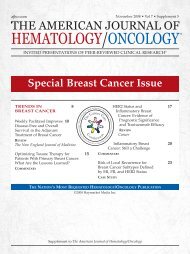Understanding palliative care - Haymarket Media Group
Understanding palliative care - Haymarket Media Group
Understanding palliative care - Haymarket Media Group
You also want an ePaper? Increase the reach of your titles
YUMPU automatically turns print PDFs into web optimized ePapers that Google loves.
E ach<br />
year, nearly two million older adults die from<br />
non-traumatic causes, many from chronic progressive<br />
illnesses. Sadly, individuals with complex<br />
illness are often unaware of <strong>palliative</strong> <strong>care</strong> services that<br />
can lend much-needed support and serve to enhance<br />
their quality of life over the course of their illness.<br />
Designed to meet the comprehensive spiritual, emotional<br />
and physical needs of those with complex illnesses,<br />
as well as the needs of their family <strong>care</strong>givers, <strong>palliative</strong><br />
<strong>care</strong> is a service whose value cannot be overestimated.<br />
Unfortunately, it’s one that is still being underutilized.<br />
Nowhere is that more apparent than in the realm of<br />
pain management. Research consistently shows that pain<br />
— a seriously debilitating symptom for many with<br />
chronic or progressive illness — is frequently undertreated<br />
in the long-term <strong>care</strong> environment, and beyond.<br />
It’s been shown that between 33% and 83% of nursing<br />
home residents experience ongoing pain that impairs<br />
mobility, leads to depression and diminishes quality of<br />
life. The fact that people are living longer with chronic<br />
illness further underscores the need for <strong>palliative</strong> <strong>care</strong>.<br />
“Pain is a big problem for many and that’s a real<br />
shame because it’s absolutely unnecessary. Just because<br />
someone has a (complex) illness that does not mean<br />
suffering needs to go along with it,” stressed Diane<br />
Meier, MD, FACP, director of the Center to Advance<br />
Palliative Care, New York.<br />
Pain isn’t the only symptom that can be alleviated<br />
through a well-designed and well-implemented <strong>palliative</strong><br />
<strong>care</strong> program, however. Depending upon the illness,<br />
individuals may also suffer from nausea,<br />
breathing problems, digestive disturbances, depression,<br />
anxiety and scores of other unpleasant and distressing<br />
symptoms that can rob them of their quality of<br />
life and make getting through each day a challenge.<br />
Not surprisingly, these disease management shortcomings<br />
dramatically differ from the needs and wants<br />
of individuals with complex illness. Numerous studies<br />
indicate that people with serious illness want vigorous<br />
treatment of pain and symptoms; relief from worry,<br />
anxiety and depression; ongoing communication<br />
about their illness and <strong>care</strong> options; coordinated, multidisciplinary<br />
<strong>care</strong> throughout their illness course, with<br />
anticipation of future <strong>care</strong> needs; decision-making support<br />
and assistance for themselves and their family<br />
<strong>care</strong>givers; and closely monitored, highly communicated<br />
<strong>care</strong> that lends a sense of safety and security in a<br />
sometimes confusing health<strong>care</strong> system.<br />
at the coreUNDERSTANDING<br />
A case for<br />
compassion<br />
Concerned that <strong>palliative</strong><br />
<strong>care</strong> is a costly<br />
program? Think again.<br />
Studies consistently<br />
show that patient-centered<br />
management of<br />
complex cases can<br />
reduce costs without<br />
shortening life. In fact,<br />
it’s been shown that<br />
reduced inpatient symptoms<br />
and fewer admissions,<br />
hospital days and<br />
emergency department<br />
visits are all benefits of<br />
patient-centered management.<br />
This approach<br />
has also been shown to<br />
cost $18,599 less over<br />
an 18-month period<br />
than non-patient-centered<br />
management of<br />
complex cases.<br />
Source: Sweeney, AMJC,<br />
February 2007<br />
Ever<strong>care</strong><br />
Overcoming misconceptions<br />
So why — despite <strong>palliative</strong> <strong>care</strong>’s far-reaching benefits<br />
— is the service still not being offered or accessed to its<br />
fullest? Experts believe misinformation and lingering<br />
misconceptions are, in great part, to blame.<br />
For starters, <strong>palliative</strong> <strong>care</strong> is often confused with hospice<br />
<strong>care</strong>. “Hospice is a form of <strong>palliative</strong> <strong>care</strong>, but it’s<br />
important to realize that <strong>palliative</strong> <strong>care</strong> is not synonymous<br />
with hospice. They are not one and the same,”<br />
said Stephen Connor, Ph.D., vice president for research<br />
and international development, National Hospital and<br />
Palliative Care Organization, Alexandria, VA.<br />
“What some people don’t understand is you can<br />
receive <strong>palliative</strong> <strong>care</strong> while still receiving or seeking<br />
curative treatments,” Connor added. He noted that<br />
those receiving <strong>palliative</strong> <strong>care</strong> not only benefit from<br />
relief of suffering, but also <strong>care</strong> teams working in tandem<br />
to devise the best <strong>care</strong> and support plans throughout<br />
the course of illness.<br />
The CAPC stresses that <strong>palliative</strong> <strong>care</strong> actually<br />
affirms life by supporting the patient’s and family’s<br />
goals for the future, including their hopes for cure or<br />
life-prolongation, as well as their hopes for peace and<br />
dignity throughout the course of illness, the dying<br />
process and death.<br />
At the heart of those goals are interdisciplinary <strong>care</strong><br />
teams that include medical and nursing specialists,<br />
social workers, counselors, pharmacists, therapists,<br />
nutritionists, clergy and other health professionals<br />
as needed.<br />
The team works in partnership with the patient or<br />
resident’s primary physician to expand traditional disease-model<br />
medical treatments to include the goals of<br />
enhancing quality of life for patients and family members,<br />
help with decision-making, and provide opportunities<br />
for personal growth.<br />
Another common and damaging misconception is<br />
that managing pain with opioid analgesics poses a toxicity<br />
risk that can hasten the dying process and place<br />
patients in a drug-induced fog.<br />
“People believe that pain medication kills, but the<br />
reality is pain is (what’s very bad for a person’s health),”<br />
Meier stressed. She explained that more than 90% of<br />
pain episodes and other symptoms can be effectively<br />
treated with standard analgesic therapies provided and<br />
closely monitored by a <strong>palliative</strong> <strong>care</strong> program. “Pain<br />
that goes untreated is the problem – not the drugs that<br />
manage it.”<br />
PALLIATIVE CARE 3
















